

Damion Smy
Influx of brands to Australia poses threat to car industry, says Toyota
7 Minutes Ago
Mazda's 'mild-hybrid' SkyActiv-X engine has been subject to lot of hype, but it's overwhelmingly normal in everyday use – for better or for worse.



Marketplace Editor
New from
$29,990
excl. on-roads

Marketplace Editor
New from
$29,990
excl. on-roads


Marketplace Editor
New from
$29,990
excl. on-roads

Marketplace Editor
New from
$29,990
excl. on-roads
Quickly see how this car stacks up against its competition. Select any benchmark to see more details.
Where expert car reviews meet expert car buying – CarExpert gives you trusted advice, personalised service and real savings on your next new car.
The Mazda CX-30 – as well as the latest Mazda 3 on which it’s based – is the latest play by the Japanese manufacturer to venture into ‘premium’ territory.
It’s got all the makings of a luxury car: edgy design, a beautifully built and finished cabin, heaps of equipment and tech, and a high price tag particularly at the upper end of the range.
Arguably what the CX-30 has lacked since launch is a premium drivetrain, with its naturally-aspirated 2.0- and 2.5-litre petrol engines not really giving the Mazda the edge against established rivals from Europe, or even its fellow Lexus from Japan.

The company’s latest SkyActiv-Xpetrol engine is meant to change that, bringing 24V (not 48V) mild-hybrid technology, and an innovative spark-controlled compression-ignition combustion process designed to bring diesel-like low-end torque with the free-revving power delivery and drivability of a petrol engine.
It’s meant to be more efficient, too, using a claimed 0.8L/100km less than the equivalent 2.5-litre petrol engine with all-wheel drive in the case of the CX-30, at 6.0L/100km on the combined cycle. Additionally, it’s claimed to be more efficient than the base 2.0-litre front-driven CX-30 (6.5L/100km).
Does this flagship Mazda CX-30 with a flagship powertrain propel the brand into contention with the likes of Audi, BMW, Lexus and Mercedes-Benz? Or does it miss the mark?

The X20 Astina AWD grade of CX-30 is listed from $46,490 before on-road costs, making it the most expensive variant in the crowded line-up of four trim levels, three powertrains and the option of front- and all-wheel drive.
Our test car has one of three cost-option exterior paints, Soul Red Crystal, asking for an extra $495. That takes the as-tested list price to $46,985 before on-roads.
It’s $3000 more expensive than the equivalent all-wheel drive G25 Astina AWD ($43,490), and $7500 than the most affordable Astina variant, the front-drive G20 Astina ($38,990).
For the extra spend over the other Astina grades, there’s no added features or specs other than the SkyActiv-X powertrain which comes as standard with all-wheel drive for the Australian CX-30 range.

That’s at the very pointy end of the mainstream small SUV class, with rivals including the Kia Seltos GT-Line ($43,290 drive-away), the Skoda Karoq 140TSI Sportline ($42,290 drive-away) and the Volkswagen T-Roc 140TSI Sport ($40,490 list).
From the premium players, there’s the Audi Q2 40 TFSI Sport ($49,400 list), Audi’s larger Q3 35 TFSI ($46,400 list), the BMW X2 sDrive18i ($48,900 list), and the Lexus UX200 Luxury ($46,500 list).
As for the Mercedes-Benz GLA200, you’d need to push the budget out by around $10,000 at $55,100 list.
Clearly, there’s no shortage of rivals regardless of whether you’re looking at mainstream or premium brands.
MORE: Mazda 3 and Mazda CX-30 SkyActiv-X pricing and specs

Buy your new car without the stress. It's fast, simple and completely free.

Great service from Travis and team, second time I have used this business would not hesitate to recommend them to anyone
Craig C.
Purchased a Ford Ranger in Sunshine Coast, QLD
CarExpert helped Craig save $7,224 on his Ford Ranger, now let us save you on your next new car.
Get your BEST priceBeing the flagship grade, the CX-30 X20 Astina has pretty much everything the company can throw at it, and then some.
Standard equipment on all Astina models includes adaptive LED headlights with LED daytime running lights, a 12-speaker Bose surround sound system, heated front seats and steering wheel, a powered tilt and slide sunroof, a frameless rear-view mirror, an electric tailgate, and the Vision Technology Pack – meaning a 360-degree camera system, Cruising and Traffic Support (stop/go for the adaptive cruise system), driver attention monitoring, and front cross-traffic alert.

Features carried over from lower grades include leather seats (Astina exclusively offers a white leather option), front parking sensors, auto-dimming mirrors, electric driver’s seat with memory, 18-inch alloy wheels, dual-zone climate control, and a leather-wrapped steering wheel with paddle shifters.
There’s also a leather gearshift, electric folding side mirrors, an 8.8-inch navigation system with Apple CarPlay and Android Auto (both wired), DAB+ radio, automatic headlights and wipers, a 7.0-inch TFT instrument cluster, a colour head-up display, and keyless entry with push-button start.
All CX-30 variants come comprehensively equipped in terms of standard assistance and active safety technologies too – we’ll touch on those in the safety section.
You certainly get a lot of car for the money. Compared to mainstream competitors as well as premium ones, the CX-30 Astina – regardless of powertrain – isn’t wanting for much.

According to the authorities in crash testing, very much so.
The CX-30 wears a 2019-stamped five-star ANCAP and Euro NCAP safety rating, based on tests conducted in Europe when the vehicle was launched in the region.
Mazda’s small SUV was one of the best-performing vehicles of 2019, posting scores of 99 per cent for adult occupant protection, 88 per cent for child occupants, 80 per cent for vulnerable road users and 76 per cent for safety assist.
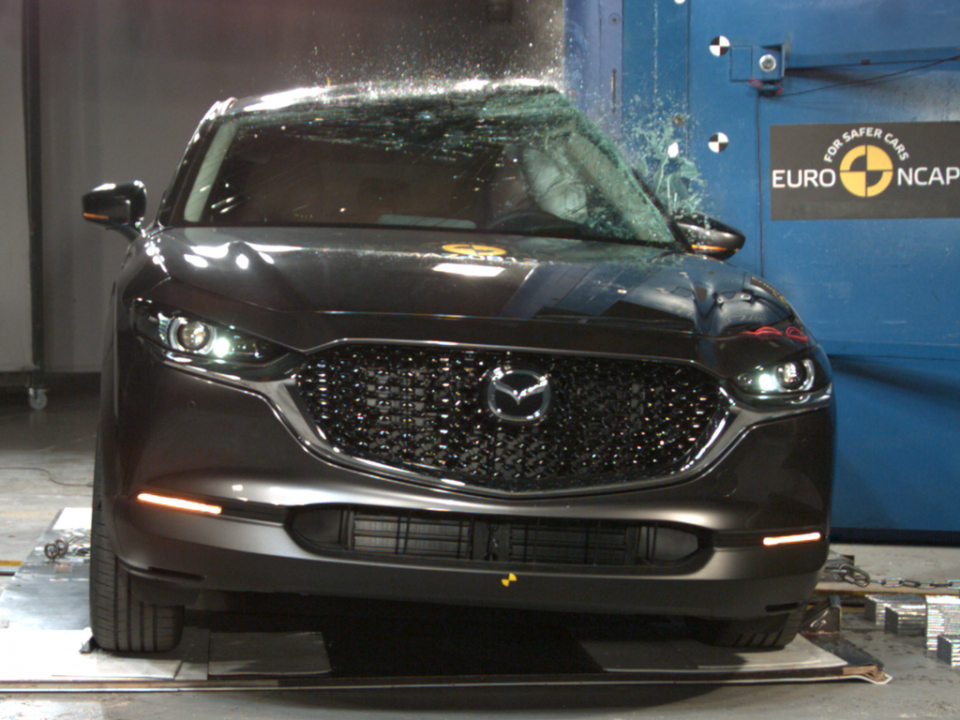
Dual frontal, side chest, side curtain and driver knee airbags are standard on all models, as are autonomous emergency braking (City, Interurban and Vulnerable Road User), lane-keeping assist with lane departure warning, and an advanced speed assistance system.
The CX-30 also has AEB in reverse as part of the rear cross-traffic assist system, as well as a reversing camera, blind-spot monitoring, front and rear parking sensors, and adaptive cruise control (with stop/go on Astina models as standard).
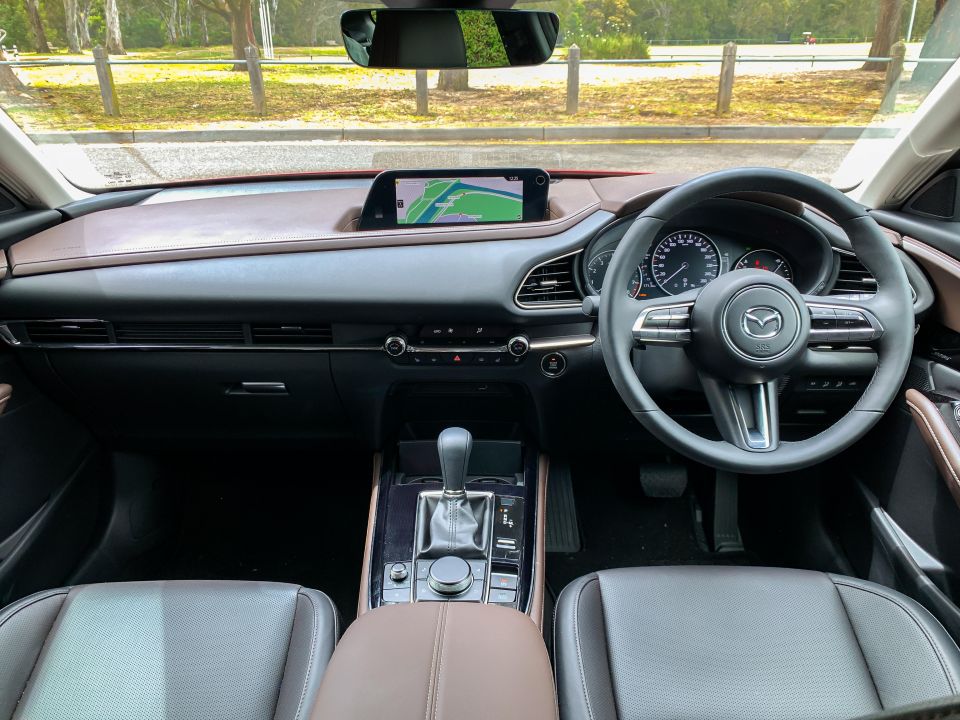
As a number of manufacturers – including Volkswagen, to my annoyance – continue to reduce interior quality and tactility in pursuit of cost-cutting and the integration of new technology, it’s pleasing to see Mazda continue to prioritise a premium look and feel in terms of the cockpit design.
Everything you can see and touch at the upper and mid-level sections of the cabin presents beautifully and feels upmarket. It’s very Lexus-like, perhaps even better – and the UX has a similar layout.
Soft-touch materials are in abundance throughout, while the leather and leather-look trims on the seats and doors feels high-quality and hardy enough to stand the test of time. To be honest, you could cover the Mazda badge on the wheel and be fooled into thinking you’re sitting in a luxury European car.
Given the X20 Astina is over $50,000 on the road, you’d want it to feel that way. It’s not perfect, though.


Call me crazy but I appreciate a quality headliner, and oddly the Mazda’s doesn’t really look or feel like one. Where carmakers like Volkswagen persist with nice textile linings on the cabin ceiling, the CX-30 employs a cheaper material that doesn’t really match the rest of the cabin.
Ditto the brown accents. With a more neutral exterior colour, maybe, but with our tester’s optional Soul Red Crystal it just doesn’t match.
Small niggles aside, there’s good space up front and the seats are really comfortable. The electric adjustment for the driver’s side with lumbar support means you can really fine-tune the driving position, and there’s two-position memory for you and your significant other – or whoever you share the vehicle with.
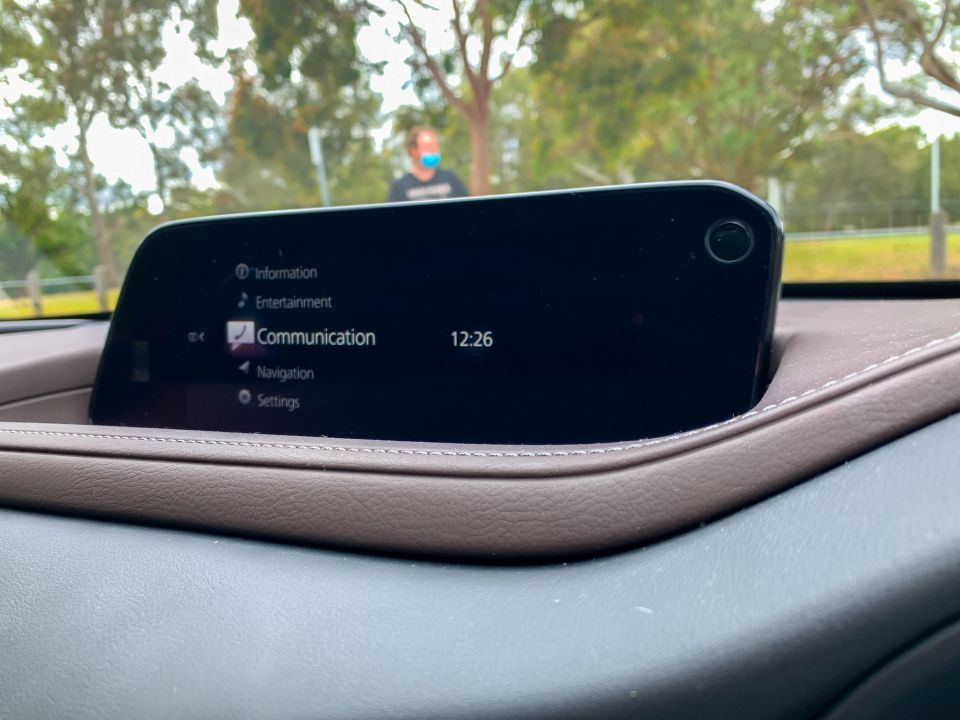

The 8.8-inch infotainment system looks a little small because it’s housed in such a large area, but it’s a significant improvement over the previous-generation MZD Connect system that still serves in the majority of Mazda’s current range.
Resolution is crisp, it’s quick to respond to inputs and the smartphone mirroring function worked seamlessly. The rotary dial and click wheel are easy use regardless of whether you’re at a standstill or on the move, though people who prefer touchscreens aren’t catered for at all here. There’s also no wireless smartphone charger, just a cubby to put your phone.
Storage is pretty good up front, with a big cubby under the front centre armrest, decent sized door bins, and cupholders ahead of the gearshift.




In the second row, it’s not quite as luxurious or spacious, but still good enough and competitive for the class. There’s directional air vents, a fold-down centre armrest with cupholders, and just one map pocket behind the front passenger seat. Parents will make use of the ISOFIX mounts on the outboard rear seats, as well as top-tether points across all three pews.
Head- and legroom is adequate but not standout, something to consider if you’re going to regularly going to cart about lanky teens or adults. There’s also a decent centre hump in the floor meaning three adults in the back will likely not want to be friends with you afterwards, and there’s no USB charging ports.
Again that’s pretty par for the course in the compact crossover segments, and the CX-30 is still at the higher end of the segment for rear amenities, though perhaps not for outright space.




Behind the second row is a 317 boot (VDA) in five-seat configuration – a small boost over the related Mazda 3 hatchback’s 295-litre effort.
Mazda doesn’t actually quote a boot volume with the rear seats down, but we can say the space is nicely square and there’s an almost flat load area with the second row folded.
Rivals like the Kia Seltos and Nissan Qashqai easily win for outright practicality especially on paper, but given the popularity of the smaller CX-3 we don’t think the CX-30’s boot volume is that much of an issue for prospective buyers.
Under the boot floor there’s a space-saver spare wheel, which also houses the Bose audio system’s sub woofer.
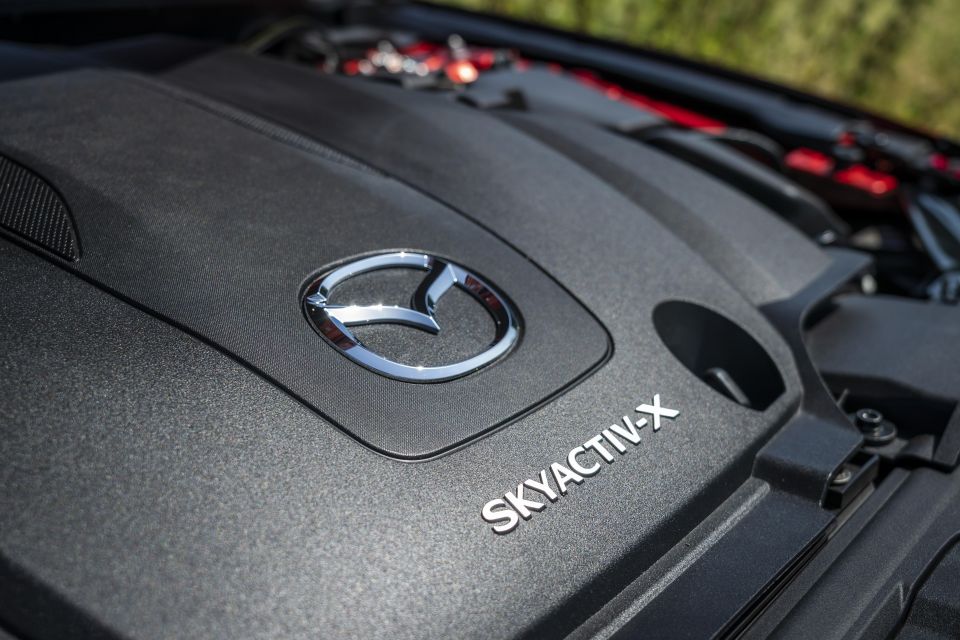
Where expert car reviews meet expert car buying – CarExpert gives you trusted advice, personalised service and real savings on your next new car.
The biggest difference between the ‘X20’ Astina and its ‘G20’ and ‘G25’ equivalents is what lives in the engine bay.
Mazda’s trick SkyActiv-X 2.0-litre supercharged petrol engine employs a spark-controlled compression-ignition combustion process which is claimed to be up to 30 per cent more fuel efficient than a conventional petrol engine, combining the efficiency and lower-end torque of a diesel with the performance and driveability of a petrol.
Mazda says: “This engine switches seamlessly between conventional spark ignition and a compression ignition mode where a lean fuel-air mix is compressed so it combusts more efficiently – releasing fewer emissions than a conventional engine”.

Outputs are quoted as 132kW at 6000rpm, and 224Nm at 3000rpm. That’s a little down on the G25 2.5-litre’s 139kW (@6000rpm) and 252Nm (@4000rpm) but up on the G20’s 114kW (@6000rpm) and 200Nm (@4000rpm).
In the CX-30, that’s sent to an on-demand all-wheel drive system as standard via a six-speed automatic transmission. The Mazda 3 X20 is front-drive only in Australia, but offers the choice of manual and auto gearboxes.
Additionally, the X20 employs 24V mild-hybrid technology combining a lithium-ion battery and integrated starter generator in place of a traditional alternator and starter motor. Like other mild-hybrid systems, this helps to power the vehicle’s electrics and assist the engine under acceleration (though Mazda doesn’t quote any add-on outputs).
Further, the ‘M Hybrid’ setup offers regenerative braking to capture energy that would otherwise be lost when decelerating, and can also engage the idle stop/start system earlier (from about 20km/h) for a smoother experience when coming to a stop and also saving more fuel.

In terms of official fuel figures, Mazda claims the CX-30 X20 AWD will use 6.0L/100km on the combined cycle, which isn’t quite as efficient as a series hybrid. But the more drivetrain setup should mean a more engaging drive – in theory, anyway.
Compared to the G25 Astina with all-wheel drive, the SkyActiv-X model is said to use 0.8L/100km less on the combined cycle and a significant 1.7L/100km less in urban environments, also resulting in lower emissions. It demands 95 RON as a minimum.
The X20 has the same 48-litre fuel tank as other all-wheel drive CX-30 models (2.0-litre FWD variants get 51L tanks), making for a theoretical driving range of 800 kilometres per fill – almost 100km more than the G25 AWD.
Let’s see if that translates in the real world.

Having had no previous experience with Mazda’s SkyActiv-X engine, I was very interested to see how the new motor compared to my time with the G20 and G25 versions of the CX-30.
It’s no secret the CX-30 is a nice car to drive, just how nice depends on the powertrain.
My recent review of the G20 Evolve found the base 2.0-litre it feels a little underdone in the bigger, heavier body of the CX-30 (it’s adequate in the 3) especially if you regularly venture onto the freeway.
Compared to the base 2.0-litre petrol, the supercharged and mildly-electrified SkyActiv-X unit of the same capacity certainly feels stronger – albeit not as strong as the 2.5 atmo four.
There’s more torque available earlier in the rev range, though you occasionally feel you still need to wind the engine out to get the best out of it. Some people might prefer this, but others will favour the more effortless performance of a turbocharged engine.
It actually feels very familiar if you’ve driven a Mazda. The high-pitched engine note sounds the same, the rev-happy character is very similar, but there’s a stronger mid-range thanks to peak torque coming on tap 1000rpm earlier at 3000rpm (and there’s more of it compared to the 2.0-litre).
As for the ‘mild hybrid’ branding, the 24V system feels more like an extension of the idle stop/start system than an actual mild-hybrid system like we’ve seen from the Euro marques.
The CX-30 X20 has the ability to turn off the engine from around 20km/h as you come to a standstill, making the process smoother and also saving precious drops of fuel by shutting off the motor sooner. However, we tested the CX-30 over a number of hot Melbourne days and you’ll rarely see this feature engage with the air-conditioner on.
Speaking of the air-con, it was a bit weak in 30-degree plus weather, tending to make a lot of noise with high fan speeds but not cooling the cabin down very effectively. Something to note.
Further, the 24V system doesn’t coast like mild-hybrid systems in other vehicles, which saves fuel under low engine load in town. Make of that what you will.

What it appears Mazda has done here, is really tailor the technology to behave like a ‘normal’ car. That’s likely to be a good thing for some, given the debate in the CarExpert comments regarding stop/start of late, but if you love new tech and saving as much fuel possible it may not deliver the noticeable difference you’re looking for.
On the topic of fuel consumption, we saw low- to mid-8.0L/100km in combined driving with a skew to moderate-traffic urban commuting on hot days, which isn’t awful when you consider most rivals post similar real-world figures… but it’s disappointing given Mazda is really pushing the efficiency of the SkyActiv-X powertrain.
Beyond the engine, the CX-30’s traits hold strong in the case of the X20 Astina.
Overall comfort and refinement is at the upper end of the segment, with good compliance in the passive suspension setup (even with a less sophisticated torsion beam rear) and impressive insulation from road and wind noise.
You will start to hear a bit of tyre roar on coarse-chip black top, but compared to some cheap-feeling mainstream rivals the CX-30 is up there with the best.
The steering is mostly a delight with fluid, predictable response as you add lock while offering enough feedback to keep you connected to the front wheels, without being so heavy that navigating tight streets or parking spaces becomes a chore.
With that said, we noticed there can be a bit of kick back or rattle through the steering rack if you hit a road imperfection while cornering at any speed, which does dent that insulated, premium ambience it otherwise mostly delivers on.

The CX-30’s chassis delivers an engaging experience without sacrificing comfort, allowing a natural-feeling degree of body roll (sort of like and MX-5) balanced with keen turn-in and good grip.
While the SkyActiv-X engine lacks the outright punch of some turbocharged rivals, it still offers decent performance on a winding backroad and the free-revving nature of naturally-aspirated engines that many are fond of.
If you want to take a little more control of the powertrain, there’s a manual mode for the transmission and steering-mounted paddle shifters to change cogs yourself, and the ‘Sport’ mode switch sharpens throttle response and holds onto gears when in Drive.
Long story short, it still offers everything you’d normally love about a Mazda but also with some of the shortcomings.
The 1.8-litre turbo-diesel available in overseas markets would be a torquier option (270Nm @1600rpm) for higher-grade CX-30 models that’d offer similar economy to the SkyActiv-X motor, along with superior highway performance to all the current petrol offerings.

Like all Mazdas, the CX-30 is covered by a five-year, unlimited-kilometre warranty with five years of roadside assistance.
Maintenance is required every 12 months or 10,000 kilometres, whichever comes first, with the first three years or 30,000km of servicing quoted at $344, $374 and $344 for a total of $1062.
It’s worth noting the 10,000km intervals are shorter than many rivals that allow 15,000km between trips to the dealer, but if you don’t do much other than commute to work you’ll probably be fine.

We noted fuel consumption earlier, and the X20 is alone in the CX-30 range in that it demands 95 RON premium unleaded as a minimum – G20 and G25 models happily run on 91 RON regular unleaded.
Our real-world fuel consumption in the vicinity of 8.0L/100km means you can expect a realistic range of around 600 kilometres per fill of the CX-30 AWD’s 48L tank.
While it’s not very close to Mazda’s official 6.0L/100km claim, we did just about match the figure indicated by the G20 Evolve from a few months ago with far less highway driving, higher-traffic urban commuting and warmer weather requiring the air-con to be on full blast most of the time (set at 23.5 degrees celsius).

Buy your new car without the stress. It's fast, simple and completely free.

Great service from Travis and team, second time I have used this business would not hesitate to recommend them to anyone
Craig C.
Purchased a Ford Ranger in Sunshine Coast, QLD
CarExpert helped Craig save $7,224 on his Ford Ranger, now let us save you on your next new car.
Get your BEST priceThere’s no question the Mazda CX-30 is a great small SUV. In fact it’s one of the best ones you can buy right now.
What is in question is whether the X20’s innovative new SkyActiv-X engine is worth the extra spend. I’d say no.
For the high price and the corporate hype Mazda has been communicating for yonks, the CX-30 X20 Astina was rather underwhelming with regards to its fuel efficiency and mild-hybrid technology.

The G25 2.5-litre petrol is more powerful, torquier, and offers comparable efficiency based on our own testing. Given Aussies tend to do a lot of highway driving too, it’s better suited for that environment.
Unfortunately for the CX-30 with SkyActiv-X, it’s too expensive and offers limited real-world benefit compared to the G25 Astina, which can be had in both front- and all-wheel drive for thousands cheaper.
As for whether it properly challenges the premium brands, we’d wager Mazda Australia would be better off bringing the 169kW/420Nm 2.5-litre turbo recently introduced in the US. Wouldn’t that be nice.
Click the images for the full gallery
MORE: Mazda CX-30 news and reviews MORE: Mazda news and reviews
Where expert car reviews meet expert car buying – CarExpert gives you trusted advice, personalised service and real savings on your next new car.
James Wong is an automotive journalist and former PR consultant, recognised among Australia’s most prolific motoring writers.


Damion Smy
7 Minutes Ago


Ben Zachariah
1 Hour Ago


Ben Zachariah
1 Hour Ago


Derek Fung
3 Hours Ago


James Wong
9 Hours Ago
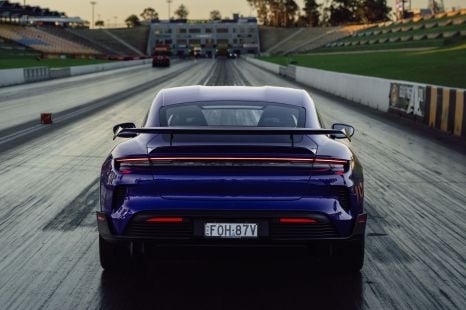

Toby Hagon
16 Hours Ago